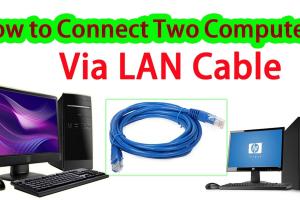Simple Guide to Setting Up Two Computers for LAN Networking

-
Quick Links:
- Introduction
- Understanding LAN
- Requirements for Setting Up LAN
- Setting Up Wired LAN Connection
- Setting Up Wireless LAN Connection
- Configuring Network Settings
- Troubleshooting Common Issues
- Case Studies & Examples
- Expert Insights
- FAQs
Introduction
Setting up a Local Area Network (LAN) between two computers can greatly enhance your productivity, gaming experience, or file sharing capabilities. Whether you're a gamer looking to connect for multiplayer sessions or someone needing to share files across devices, knowing how to establish a LAN connection is essential. This guide provides a step-by-step approach to setting up your LAN, covering both wired and wireless connections.
Understanding LAN
A Local Area Network (LAN) is a network that connects computers and devices within a limited area, such as a home, office, or school. LANs enable high-speed data transfer, file sharing, and resource sharing among connected devices. Unlike WANs (Wide Area Networks), LANs offer faster speeds due to their limited geographic range.
Common LAN topologies include:
- Star Topology: All devices are connected to a central hub.
- Bus Topology: All devices share a single communication line.
- Mesh Topology: Each device connects to multiple others, creating redundancy.
Requirements for Setting Up LAN
Before you begin, gather the following equipment:
- Two computers (desktop or laptop).
- Network cable (for wired connections) or a wireless router (for wireless connections).
- Network interface cards (NICs) installed on both computers.
- Network configuration software (optional).
Setting Up Wired LAN Connection
Step 1: Connect the Computers
Use an Ethernet cable to connect both computers directly. If you're using a router, connect both computers to the router via Ethernet cables.
Step 2: Configure the Network Settings
Follow these steps to configure your network settings:
- Open the Control Panel on both computers.
- Select Network and Sharing Center.
- Choose Change adapter settings.
- Right-click on Local Area Connection and select Properties.
- Double-click on Internet Protocol Version 4 (TCP/IPv4).
- Select Use the following IP address and enter the following:
- Computer 1: IP Address: 192.168.1.1, Subnet Mask: 255.255.255.0
- Computer 2: IP Address: 192.168.1.2, Subnet Mask: 255.255.255.0
- Click OK and close all windows.
Setting Up Wireless LAN Connection
Step 1: Set Up the Wireless Router
Connect your wireless router to your modem. Power it on and ensure it's functioning properly.
Step 2: Connect the Computers to the Wireless Network
On both computers, follow these steps:
- Click on the Wi-Fi icon in the taskbar.
- Select your network from the list of available networks.
- Enter the Wi-Fi password when prompted.
- Confirm the connection.
Step 3: Configure Network Settings
For wireless connections, you may still need to assign static IP addresses as described in the wired connection section.
Configuring Network Settings
Configuring settings correctly is crucial for a successful LAN setup. Once both computers are connected, ensure they can see each other:
- On Computer 1, open File Explorer.
- Type \\192.168.1.2 in the address bar (replace with the IP address of Computer 2).
- If prompted, enter the username and password of Computer 2.
- Repeat this process on Computer 2 to access Computer 1.
Troubleshooting Common Issues
If you encounter issues, check the following:
- Ensure that both computers are on the same subnet.
- Check firewall settings that may restrict file sharing.
- Verify that network discovery is turned on in the Network and Sharing Center.
- Restart both computers and the router.
Case Studies & Examples
Consider a scenario where two friends, Alex and Jamie, want to play a multiplayer game. They set up a LAN connection using a router. Within minutes, they were able to connect their computers and enjoy a smooth gaming experience without lag. This simple setup allowed them to share resources, enhancing their collaborative gaming sessions.
Expert Insights
Experts recommend ensuring that your network hardware is up to date for optimal performance. Using quality Ethernet cables and routers can significantly reduce latency and improve connection stability.
FAQs
1. What is LAN?
A LAN, or Local Area Network, connects computers within a limited area, allowing for resource sharing and communication.
2. Can I connect two computers directly without a router?
Yes, you can connect two computers directly using an Ethernet cable configured for a peer-to-peer network.
3. What type of Ethernet cable should I use?
Use a Cat5e or Cat6 Ethernet cable for optimal performance in wired connections.
4. How do I share files between two computers on a LAN?
By configuring network sharing settings and assigning appropriate permissions, you can easily share files between computers.
5. What is the difference between a wired and wireless LAN?
A wired LAN uses physical cables for connections, while a wireless LAN uses Wi-Fi technology.
6. Is it safe to use a LAN?
Yes, as long as you implement proper security measures like firewalls and strong passwords.
7. Can I connect more than two computers on a LAN?
Absolutely! You can connect multiple devices using switches or routers.
8. What should I do if I can’t see the other computer?
Check your network settings, firewall configurations, and ensure both computers are on the same subnet.
9. How can I improve my LAN speed?
Use high-quality hardware, minimize interference, and optimize your network settings for better speed.
10. Can I use a LAN for gaming?
Yes, LANs are ideal for gaming, providing low latency and high-speed connections for an enhanced experience.